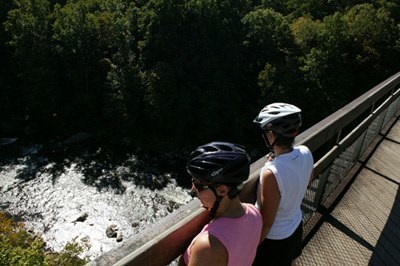|
The Potomac Heritage National Scenic Trail follows the route of the Potomac River, tracing the path of early American history and westward expansion. The history of the Potomac predates the American Revolution, but its influence on the nation from its early days until now is highlighted here.
The George Washington EraGeorge Washington grew up along the Potomac River and developed his surveying skills from a young age, becoming familiar with the land in the basin. During his time at war, he further developed his skills through surveying the interior of America for the extensive resources it provided. Following the American Revolution, he inspected the land again to determine river routes for inland navigation, recognizing its potential for transport, power, and an abundant fisheries resource. To capitalize on this potential and facilitate commerce to the west for a growing nation, he founded the Potowmack Company to construct a series of skirting canals to connect river networks and improve the navigability of the Potomac. Its construction started in 1785 and ended in 1802, where it would then be operational for 26 years until going bankrupt. The company went bankrupt due to a combination of labor issues, poor navigability, piling financial burdens, and bad weather. Following its failure, the C&O Canal Company took over the charter with the goal of constructing a canal on the other side of the river that would connect the east to northwest territories.
Library of Congress / Geography and Map Division Development Along the RiverMany towns thrived along the Potomac, with the river facilitating trade and industry. In 1790, Alexandria extended its shoreline two full blocks into the Potomac, becoming a port city. Port cities like Alexandria flourished in commerce and industrial development on the Potomac. This was partly due to their geographic locations along the Fall Line, where the change in topography generated waterpower to be harnessed for mills and factories.Once C&O Canal was completed in 1850, canal barges transported goods as far as Cumberland in Western Maryland and brought coal from the mountains down to Georgetown. Transportation along the canal supported economic growth for the towns along the river. An Escape Route and a Dividing LineDue to its geographic location, the Potomac River served as an escape route for enslaved people seeking freedom. Its rough terrain, particularly in the Great Falls section, provided many hiding spots and lookout points. On April 15, 1848, the largest single escape attempt in United States history took place when 77 enslaved people fled Washington D.C. and Alexandria, boarding a bay-craft schooner called the Pearl. The Pearl was to sail southward on the Potomac River, eventually reaching Philadelphia. Unforeseen circumstances led to the Pearl’s discovery, and the passengers were brought back to Washington.The Potomac River also served as a dividing line during the Civil War, witnessing several significant battles. The river provided many obstacles for both the Union and Confederate Armies and was used strategically for transport, moving troops, and obtaining war supplies. It also served as a means for freedom seeking along the Underground Railroad, with routes of assistance for freedom seekers made possible with the wide-reaching routes present in the Potomac River waterways. Facing the Impacts of a Booming PopulationWashington D.C. began increasing in size during the 1860s, becoming a hub for freed people when they were emancipated. Following the Civil War, D.C. absorbed more land, including Georgetown, and the city continued to grow. At the start of the Civil War, it had around 75,000 residents and by 1870 the numbers were reaching around 130,000. Again between 1900 and 1950 the population went from 278,000 to 800,000, with the onslaught of the first World War accelerating this growth.As the population along the Potomac grew, water quality began declining as a result of improper water treatment systems, acid drainage from abandoned coal mines, and algal blooms from excess nitrogen and phosphorous entering the waterways. Poor water quality, in combination with barriers to upstream migration and a century of overfishing, led to the decline of the American shad, a fish with an important ecological role both in the ocean and the freshwater habitats of the Potomac River. The river was declared unfit for swimming in 1957 and in 1965 President Lyndon B. Johnson called the river a “national disgrace.” These discoveries contributed to an increase in water quality consciousness during the 1970s, with the Clean Water Act of 1972 laying the groundwork for addressing water quality moving forward. 
NPS Photo The Potomac TodayWith shad restocking efforts and reduction in the number of top pollutants, water quality in the Potomac has slowly been improving. Today, there is still work to be done, and efforts are ongoing. You can be a part of this effort by helping to protect forested habitats along the river, participating in trash cleanups, and planting vegetation that protects streams. The Potomac River remains a source of food, energy, and water for many communities, especially in Washington D.C., where it supplies about 80 percent of its water. The Potomac River is a unique resource connecting communities across its landscape to recreational opportunities and lessons about the nation’s history. Taking part in activities like hiking, paddling, biking, and birdwatching are ways that people can enjoy what the river has to offer. Visit Things to Do, for more information. |
Last updated: March 25, 2025
